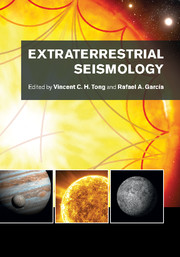Book contents
- Frontmatter
- Contents
- List of contributors
- Preface
- Acknowledgements
- List of abbreviations
- Planetary seismology: High risk, high return
- A bright outlook for helio- and asteroseismology
- Part I Observation and space missions
- Part II Data and physical parameters
- Part III Modeling approaches
- Part IV Discoveries of physical structures and processes
- 11 Asteroseismology of red giant stars
- 12 A helioseismic view of the Sun's internal structure and dynamics
- 13 Recent discoveries of structures and physical processes in local helioseismology
- 14 Seismology of giant planets
- 15 Seismicity and interior structure of the Moon
- Part V Interdisciplinary research involving planetary and astrophysical sciences
- Part VI Interdisciplinary research involving terrestrial seismology
- References
- Index
15 - Seismicity and interior structure of the Moon
from Part IV - Discoveries of physical structures and processes
Published online by Cambridge University Press: 05 July 2015
- Frontmatter
- Contents
- List of contributors
- Preface
- Acknowledgements
- List of abbreviations
- Planetary seismology: High risk, high return
- A bright outlook for helio- and asteroseismology
- Part I Observation and space missions
- Part II Data and physical parameters
- Part III Modeling approaches
- Part IV Discoveries of physical structures and processes
- 11 Asteroseismology of red giant stars
- 12 A helioseismic view of the Sun's internal structure and dynamics
- 13 Recent discoveries of structures and physical processes in local helioseismology
- 14 Seismology of giant planets
- 15 Seismicity and interior structure of the Moon
- Part V Interdisciplinary research involving planetary and astrophysical sciences
- Part VI Interdisciplinary research involving terrestrial seismology
- References
- Index
Summary
The beginning of the seismological inv estigation of the Moon dates back to the beginning of space flight: A working group implemented by NASA in 1959 (Hall, 1977) suggested the development of a seismometer for a hard landing on the Moon. This resulted in Ranger missions 3 to 5, which all unfortunately failed for technical reasons (Hall, 1977). The first measurement of elastic properties of lunar soil was conducted by the Surveyor landers a few years later (Christensen et al., 1968).
Besides these early attempts, seismological studies of the Moon divide into two phases: The first one saw the installation of a seismometer network on the Moon, starting with Apollo 11 on July 20, 1969 (Apollo 11 Mission Report, 1969), followed by the collection of continuous data until network shutdown on September 30, 1977 (Bates et al., 1979), and, in parallel and ongoing until the early 1990s, the analysis of the data. The second phase began in the late 1990s, when cheap computer power allowed for massive data processing on desktop workstations and the application of new methods.
This chapter aims to give a sketch of the Moon as it results from these two phases. The following sections will first describe the different types of seismic events observed on the Moon, and then detail the structure of the main layers of the lunar interior, i.e., the crust, mantle, and core. A summary section finally gives an overview of the present-day concept of the interior structure of the Moon.
Seismic sources and seismicity
Both endogenous and exogenous sources create seismic waves on the Moon. It is thus common to speak of “events” rather than “quakes,” unless the type of source has been identified. However, analysis of the spatial and chronological distribution of events, and of seismogram characteristics, leads to the identification of several classes of sources.
- Type
- Chapter
- Information
- Extraterrestrial Seismology , pp. 203 - 224Publisher: Cambridge University PressPrint publication year: 2015
- 1
- Cited by



